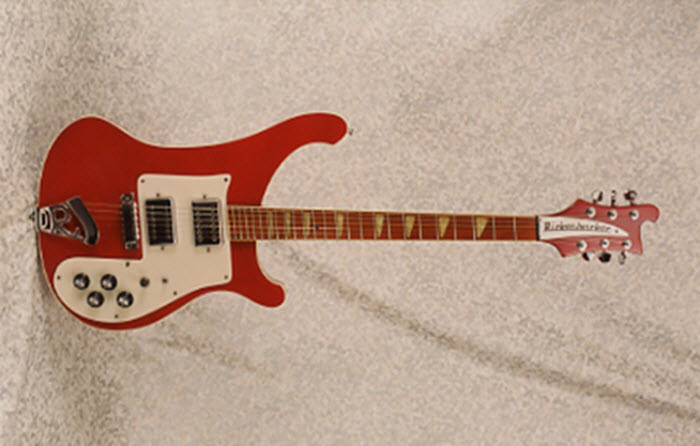
Even for someone as guitar promiscuous as me, some brands of guitar just don’t speak to me. Rickenbacker was always one of those brands for me. Not that there’s anything wrong with Rickys; it’s just a matter of personality. However, when I found out Rickenbacker made a guitar with slanted frets, that definitely piqued my interest!
Something I’ve always found curious was the discrepancy between “correct” and “incorrect” technique on the guitar. If you ever study classical guitar, you’ll get schooled on proper positioning of the left (and right, for that matter) hand, with the thumb in the middle of the back of the neck and the fingers coming down perpendicular to the strings. This helps maximize your reach and make it easier to fret the often complex harmonic line movements. It works. But then along comes Jimi who plays left-handed upside down and backwards with his darned thumb looped over the edge of the fingerboard and creates genius. Go figure.
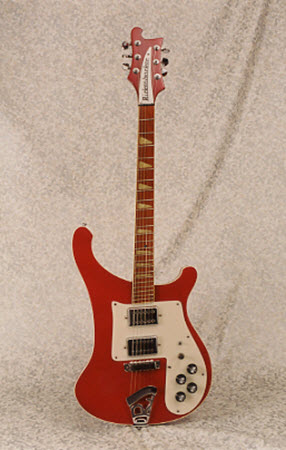
Vintage 1973 Rickenbacker 481 Electric Guitar with Slanted Frets
In any case, periodically guitar designers turn their attention to the ergonomics of the guitar fingerboard and implement improvements to the traditional parallel fret layout. In modern times Oregon luthier Ralph Novak employs his patented “fanned fret” concept—with lower frets angled toward the bass side of the head, gradually migrating in a fan-like shape so that higher frets are angled toward the bass side of the body—on his Novax guitars.
Of course, somebody has always done something before, and in this case, conceptually if not actually, at least, it was Rickenbacker who came up with the slanted frets idea in 1973 with its Model 481. Or actually they reportedly did the slanted frets as a custom option as early as 1969. Rickenbacker had a tradition of trying to improve the ergonomics of guitar necks. Back in 1961 Rickenbacker designer Peter Sceusa filed a patent for a parabolic neck profile that was narrower at the top of the back to make it easier for ladies and people with smaller hands to fret the guitar (granted 1963). Who came up with the idea of slanting the frets I don’t know, but the idea was that if you’re resting the neck in the crook of your thumb, the fingers naturally curve forward. Thus, if you angle the frets slightly forward on the bass side, it’s more comfortable to fret, more natural.
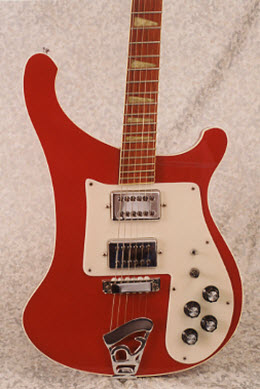
Vintage 1973 Rickenbacker 481 Electric Guitar with Slanted Frets
The notion must have been at least somewhat popular because the concept got its own guitar model with the 481 introduced in 1973. Basically this is a solidbody with what’s called the “cresting wave” shape derived from Rickenbacker’s distinctive 4001 bass guitars. Rickenbacker even came up with a pair of high-output humbuckers with 12—count ‘em—adjustable pole pieces each for the 481 which only ever appeared on this guitar. One of the toggles is a threeway select and the other is a nifty phase reversal switch.
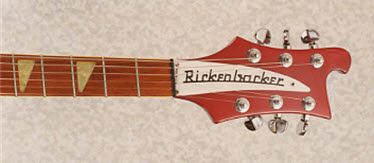
Vintage 1973 Rickenbacker 481 Electric Guitar with Slanted Frets
Hard information on the 481 is difficult to come by. The slant-fretted Model 481 was offered for 10 years from 1973-1983, but online references suggest that these are relatively scarce. There was a sort of companion Model 480 which had a similar shape, but different electronics and no slanted frets. Apparently, the Model 481 is favored by a guitarist named Serge Pizzorno of the contemporary band Kasabian, but I confess I don’t know their music (reflective of someone like me advancing on in age).
I love the idea of this guitar, even if for me the slanted frets don’t work all that well. They’re not a real obstacle to playing—they’re not that slanted—but if you favor classical technique, like I do, they’re no real advantage, and they don’t work all that well if you play a lot of barred chords. Unless maybe you’re Jimi, but who is?
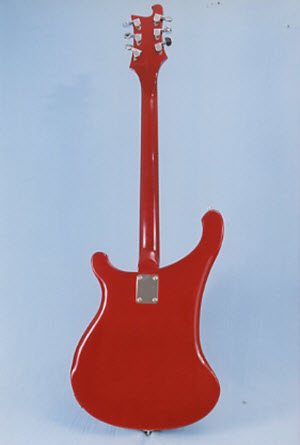
Vintage 1973 Rickenbacker 481 Electric Guitar with Slanted Frets
Certainly the Model 481 is one of the more desirable of Rickenbacker’s 1970s output, probably because it’s so unlike the usual Rickenbacker. I love phase reversal switches and I love crushed pearloid shark’s teeth inlays and even the varnished fingerboard surface. That it’s so unusual is probably why I was so attracted to the Model 481 in the first place. Well, come on. You gotta love any guitar with slanted frets. Whether or not the guitar really fits in with your personality.

I was mentioning to some friends of mine here in Denver Colorado a while back that a my friend of mine was in this band that that their Lead player played one of these. My buddy Mark was their bass player (he used a 4001 Ricky), but my friends here kept insisting that it must have been Ricky 650 or 620.
It was 1974 and my friends band was playing out on Wesley Island on the Saint Lawrence Seaway; an area close to where I grew up.
Now you have proven it for me. I new they made one…
Thanks, for this… Made my day on this one.
So cool, dig it.
Gary B [Denver, CO]
I was mentioning to some friends of mine here in Denver Colorado a while back that a friend of mine was in this band that that their Lead player played one of these. My buddy Mark was their bass player (he used a 4001 Ricky), but my friends here kept insisting that it must have been Ricky 650 or 620.
It was 1974 and my friends band was playing out on Wesley Island on the Saint Lawrence Seaway; an area close to where I grew up.
Now you have proven it for me. I new they made one…
Thanks, for this… Made my day on this one.
So cool, dig it.
Gary B [Denver, CO]
I was mentioning to some friends of mine here in Denver Colorado a while back that a friend of mine was in this band that their Lead player played one of these. My buddy Mark was their bass player (he used a 4001 Ricky), but my friends here kept insisting that it must have been Ricky 650 or 620.
It was 1974 and my friends band was playing out on Wesley Island on the Saint Lawrence Seaway; an area close to where I grew up.
Now you have proven it for me. I new they made one… hmm a model 481
Thanks, for this… Made my day on this one.
So cool, dig it.
Gary B [Denver, CO]
I see that you can’t make corrections here can you. Sorry for the three correction postings…
I actually had one of these…bought it from my first ex’s brother for $400 in 1983 and played it for a couple of years before he whined for it back. I sold it back for $400 as I needed the bucks ( hence the ex!). Really liked it and the frets were fun…thanks for the article, they’re worth quite a bit now I hear.,..I’d buy one for the right price.
I have a Ric 481 with slanted frets. I bought it a few years ago and it’s like new. Not a visible flaw anywhere… except on the fret board.. The frickin frets are slanted. I tried to play the bloody thing, but it just didn’t work for me. Not that I’m a traditionalist – far from it. It just wasn’t a comfortable player for me. It’s really just a curiosity in my ever-expanding collection now… kinda like my SRV Strat… it worked for SRV… not for MDD (i.e., me!). Or some of my other lesser known guitars, including a really bizarre Scorpion that only a true metal head could love… To me, assuming good quality craftsmanship and conventional design, guitars are all about balance and playability. And from where I sit, there are few quitars better balanced or more playable than the Fender Stratocaster. Even the SRV is very well made and well balanced… just not as playable as the rest due to the features SRV loved… the C neck especially. A good example of a horribly balanced guitar is the Gibson SG. I’d only play that guitar if my slant fret 481 Ric wasn’t available! lol. Just kidding, but it is a handful… My collection is heavy on Fender and Gibson, but I’d like to add some Rics. Any recommendations Mike?
Mark DiMattia
Newark, Delaware
One of my Customer owns a Rickcy 480 Natural, I don’t know why they made it for as long as they did, it’s an awful, feeling guitar, it’s got no soul, although I made sure he gets a real good action, it feels awful, seems to hang weird on you. A big ZEEERo
I have a Azure-glo blue one, bought new when I was in high school in 1979. I still have it. It’s a weird guitar, but sounds like a Rickenbacker if you use a compressor. The pickups really suck, low-output (like 6.2 kOhm) humbuckers, they’re weak but produce a bit of distortion on the attack, probably due to the classic RIck bridge sound. I use it for recording these days, only specific things…
I built myself a guitar with slanted frets (https://pin.it/4bR5BSv) and I am very pleased with it. When I was a kid I broke my wrist, which causes trouble now when playing barred chords near the nut. With this guitar I can play guitar much more comfortable. I needed to get used to the slanted frets in the higher positions though. But now I prefer slanted over normal frets 😉
I got a 481. Bought it in 1983 from a mate for $300 Australian. Loved the look and the feel of it. A lot of my music heroes at the time played Rickenbackers – eg Paul Weller, Pete Townsend, Roger McGuinn. Rickenbackers made such great looking guitars! (At least that’s what i thought). The 481 was my main electric guitar until the 2000s when I bought a 330. I like the sound of the 330 better – the humbuckers on 481 never did it for me. I do like the look of the slanted frets but I really never noticed the 481 being easier to play than a normally fretted guitar.
Hi,my name is David Harris Robinson, and I live in Newark, England.I invented the slanted fret idea In the 1960’s. I applied for a patent in 1968 and was granted patent rights in 1970. It took 2years to get the “letters patent” but was covered since 1968. The patent number is 1237830. Just thought I would write and let you know!. Other manufacturers copied the idea shortly afterwards, but attempts by my solicitor to contact them to ask for a copy of their patent failed to receive an answer!.
The Slant-fret idea was brought to Rickenbacker by Henry C. Perez- ref. “Rickenbacker Electric 12 String” by Tony Bacon – page 80 last sentence.
For a Rickenbacker with fanned (as opposed to slanted) frets, check out the photo here: http://guitarangel.co.uk/galleriesDetail.php?Other-makes-5
Hello,
I have a red rickenbacker 480 build in 1973 or 1974. Does anyone knows the value of this except from the emotional value ?
I have a Fireglo 1975 that’s all original except the bridge pickup was swapped out. Any idea where I can find a replacement?